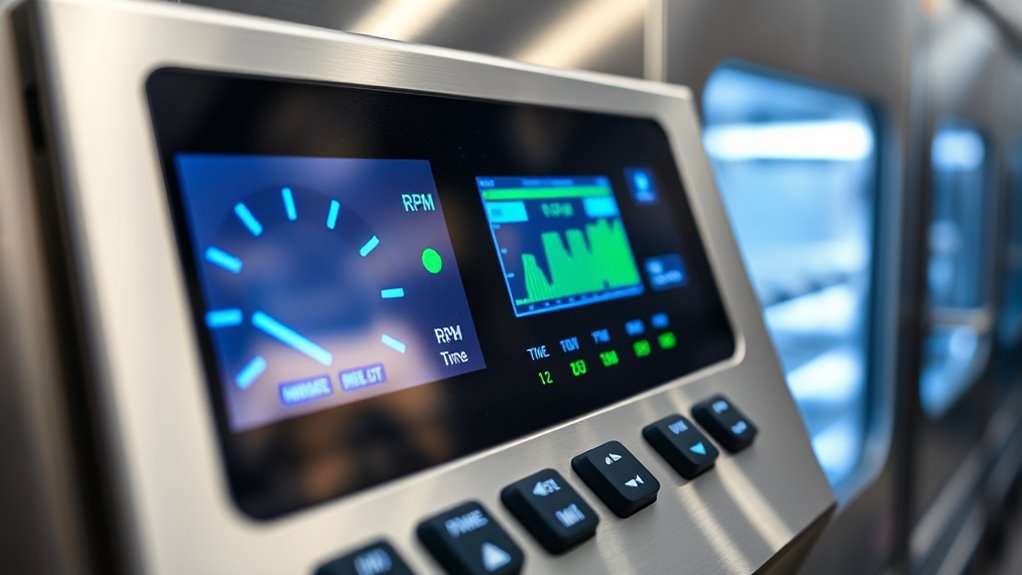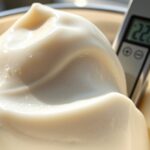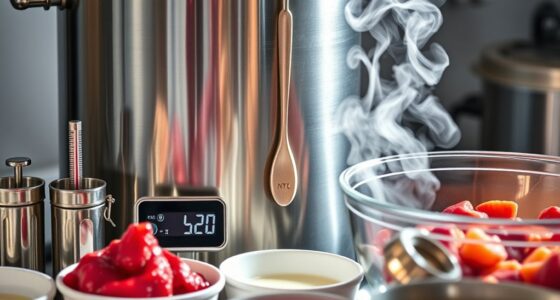To optimize your batch freezer, focus on adjusting RPM, dwell time, and finding the sweet spot. Keep RPM high enough for even freezing but avoid over-agitation, which can cause air pockets or damage. Set dwell time to quickly reach the core temperature without allowing crystals to grow too large. By fine-tuning these settings alongside temperature control, you’ll guarantee consistently superior texture and quality—if you continue, you’ll discover how to perfect your process even further.
Key Takeaways
- RPM controls the evenness of freezing; optimal RPM balances uniform cold distribution without over-agitation.
- Dwell time determines core temperature; too long causes large ice crystals, too short may prevent proper freezing.
- The “sweet spot” combines ideal RPM, dwell time, and temperature to produce small, uniform ice crystals and high product quality.
- Monitoring the freezing curve helps fine-tune parameters for efficient, consistent freezing throughout the batch.
- Precise control of these settings ensures rapid freezing, minimizes ice crystal growth, and maintains product texture and integrity.

Setting the right batch-freezer parameters is crucial to guarantee your products freeze quickly and maintain quality. One of the critical factors in achieving this is understanding how temperature control influences ice crystal formation. When you set your freezer parameters correctly, you ensure that the temperature drops rapidly enough to produce small, uniform ice crystals. Large ice crystals can damage the texture of your product, leading to a less desirable final product. Hence, precise temperature control is essential to minimize ice crystal growth, which happens if your product spends too long at temperatures where crystals can grow and merge. By optimizing your freezer settings, you facilitate rapid freezing, reducing the window for unwanted ice crystal formation and preserving the product’s integrity. Proper temperature management also involves monitoring the freezing curve, which provides insights into how quickly and evenly your product cools. Next, pay close attention to the RPM, or revolutions per minute, of your freezer’s agitator or mixing mechanism. The RPM influences how evenly your product freezes. If the RPM is too low, the freezing process becomes uneven, resulting in larger ice crystals in some areas. Conversely, too high an RPM can cause over-agitation, which might incorporate excess air or disrupt the structure of delicate products. Striking the right balance ensures consistent freezing, which promotes uniform ice crystal formation. Proper RPM settings help distribute cold more evenly throughout your batch, reducing the risk of ice crystal growth that could compromise texture and flavor. Dwell time, or the duration your product spends in the freezer at specific temperature settings, also plays a critical role. It’s tempting to think longer freezing times lead to better results, but in reality, extended dwell times can promote larger ice crystals due to prolonged exposure to suboptimal temperatures. You want just enough dwell time to reach the desired core temperature without giving ice crystals time to grow large. This means monitoring the freezing curve carefully and adjusting dwell times to match the specific product’s needs. When you optimize dwell time, you prevent the formation of large ice crystals, preserving smoothness, mouthfeel, and overall quality. Ultimately, finding the ideal combination of temperature control, RPM, and dwell time is about precision. Fine-tuning these parameters helps you create a freezing environment that fosters rapid, uniform ice crystal formation—key to maintaining product quality. When you master these settings, you’ll produce consistently superior frozen goods, with optimal texture and flavor preserved through efficient, controlled freezing. This balance ensures your batch-freezer operates at its best, giving your products the cold precision they need to shine.
Frequently Asked Questions
How Do Ambient Temperature Changes Affect Batch-Freezer Settings?
You should consider how ambient temperature fluctuations impact your batch-freezer settings. Warmer outside temperatures can cause your freezer to work harder, affecting RPM and dwell time. Proper freezer insulation helps maintain consistent internal conditions, minimizing the influence of ambient changes. By adjusting your settings accordingly and ensuring good insulation, you keep the freezing process efficient and consistent, regardless of outside temperature swings.
Can Different Ice Cream Formulations Require Unique Freezer Adjustments?
Think of your ice cream as a tailor-made suit—each formulation needs its own fitting. Different ice cream compositions, like higher fat or sugar content, can alter how they freeze. So, you should customize your freezer settings accordingly. Freezer customization helps you achieve the perfect texture and consistency, ensuring each batch matches your desired quality, no matter how unique the ice cream’s ingredients are.
How Often Should Batch-Freezer Settings Be Recalibrated for Consistency?
You should calibrate your batch-freezer regularly to maintain consistency. How often depends on usage and equipment stability, but a good rule is to check calibration weekly or bi-weekly. Consistency monitoring helps identify when adjustments are needed, ensuring your ice cream’s quality stays first-rate. Regular calibration prevents drift in settings, keeps your product uniform, and minimizes waste, so make it a routine part of your maintenance schedule.
Are There Specific Signs Indicating the Need to Modify RPM or Dwell Time?
Imagine your freezer as a busy dance floor—if ice crystals start forming unevenly, you’ll notice signs of overfreezing like icy buildup or grainy textures, signaling you to tweak RPM or dwell time. Conversely, signs of underfreezing, such as soft or sticky products, suggest you need to slow down or increase dwell time. Pay attention to these cues to keep your freezing process perfectly synchronized.
What Are the Safety Considerations When Adjusting Batch-Freezer Settings?
When adjusting batch-freezer settings, you need to prioritize safety. Make sure sanitation protocols are strictly followed to prevent contamination, and only trained staff make changes to settings. Always double-check that equipment is properly cleaned and maintained before adjustments, and communicate changes clearly to all team members. This guarantees safe operation, reduces risks, and maintains product quality, keeping everyone safe and your process compliant with health standards.
Conclusion
By mastering your batch-freezer settings—tuning RPMs and dwell time—you’re not just freezing ice cream; you’re crafting a delicate symphony of chill and texture. Imagine your perfect batch as a frozen canvas, each setting a brushstroke shaping its smoothness and flavor. When you find that sweet spot, every scoop becomes a moment frozen in time, a tribute to your skill. Keep experimenting, and turn each batch into a masterpiece that delights with every bite.















